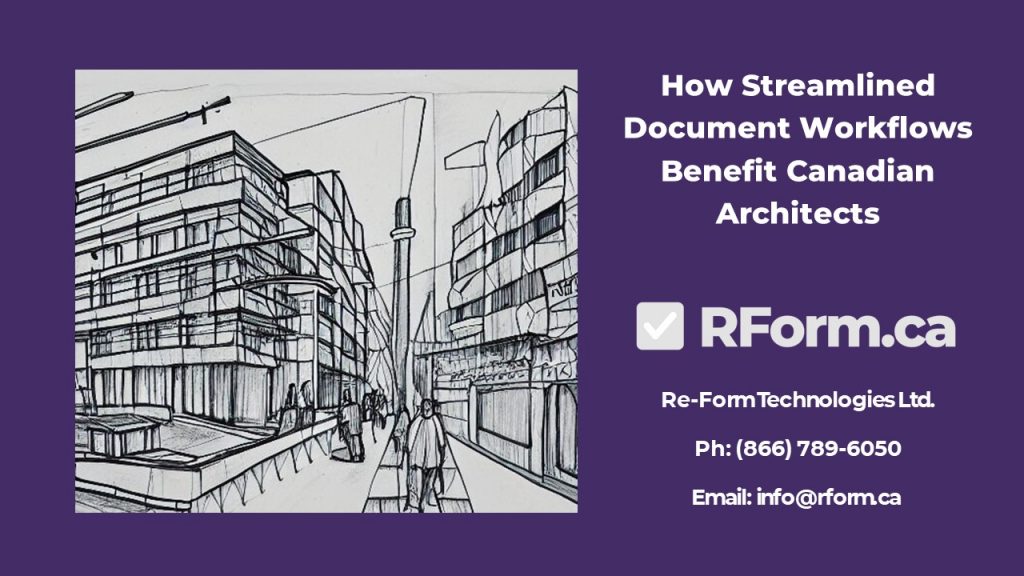
Architects in Canada often navigate a maze of administrative tasks, which can overshadow their primary mission: to design and innovate. In architecture, the challenge is not just about erecting structures but also managing the multitude of non-design-related responsibilities. This juggling act can significantly dilute an architect’s focus on the creative aspects of their work, leading to a frustrating disconnect between their skills and the demands of the job market. Streamlined Document Workflows can catalyze Canadian architects, enabling them to reclaim their creativity and construct a future that mirrors their true potential.
The reliance on spreadsheets and emails to track these tasks can be as precarious as a house of cards, especially when juggling multiple projects. The meticulous nature of these systems often leads to a tangle of data that can be challenging to unravel. The strain on time and resources is palpable, and the toll it takes on the creative process can be disheartening as architects find themselves bogged down by the minutiae rather than soaring in the realms of innovation and design.
Efficiency is paramount, and in the search for streamlined workflows by refining these processes, architects can reclaim time to dedicate to the artistry that drew them to their profession. The architectural landscape demands no less than a harmonious blend of administrative mastery and creative genius.
The creative spark igniting architectural brilliance is often doused by the deluge of administrative tasks architects wade through. This inundation can stifle creativity, as paperwork and project management demand to hijack the mental bandwidth required for design thinking. The consequence? It is a frustrating dichotomy where architects spend more time on clerical work than on the craft they are passionate about.
Such a scenario can lead to dissatisfaction, as the opportunity to engage in the fulfilling act of creation becomes a rarity. Moreover, this imbalance has a ripple effect, potentially compromising the quality of project outcomes and, by extension, client satisfaction. When the scales tip too far towards administrative chaos, the visionary structures that could have been are left as mere sketches on the drafting board.
Centralized Data Organization: Amid the paper shuffle of project management, Canadian architects are realizing that centralized data organization is not just a buzzword—it’s the cornerstone of efficiency. The pain of hopping between fragmented files and disjointed communication threads can be alleviated with a single, unified system. This isn’t just about having all your digital ducks in a row; it’s about ushering in a new era of collaboration and clarity.
- Consolidation: Imagine a world where COs, RFIs, submittals, SIs, and progress claims coexist in harmony. Centralized data means all relevant information is accessible from a singular, streamlined repository.
- Collaboration: When data is centralized, teams can work together seamlessly, no matter how complex the project. Each member can dip into the collective knowledge pool, fostering a more cohesive unit.
- Accuracy: Reducing the margin for error becomes a reality with well-organized data. Architects can rely on the most up-to-date information, minimizing costly mistakes and enhancing project execution.
For architects buried under bureaucracy, centralized data organization isn’t just a solution—it’s a lifeline back to their passion for design and creation. It’s about cutting the administrative deadweight to free the artistry within.
Centralized data organization is the foundation of this efficiency, ensuring all project stakeholders are working with easy access to the latest project revisions and documents. Reflecting on other industries, the benefits of streamlined workflows and centralized data have been well-documented. For instance, a streamlined CMS accelerates deployments and cuts ongoing costs in content management. Similarly, healthcare management has seen a leap in operational efficiency by establishing a centralized data dissemination point, ensuring informed, data-driven decision-making. These examples spotlight the transformative power of organized workflows and data, inspiring architects to construct a more streamlined future.
Increased accountability and Productivity: Increased accountability and productivity in the construction industry bring many benefits that contribute to the success of projects and the sector’s overall growth. Here are some key advantages:
- Efficiency: Enhanced accountability ensures that project tasks and responsibilities are clearly defined and assigned to the appropriate parties. This streamlines workflow and reduces the risk of delays, ultimately speeding up project timelines and improving overall efficiency.
- Cost savings: With improved accountability comes better cost control. By accurately tracking and recording project activities and expenses, construction companies can identify areas of inefficiency and implement measures to mitigate them. This leads to cost savings and maximizes project profitability.
- Reduced errors and disputes: Accountability fosters a culture of accuracy and precision. Detailed records and transparent communication minimize errors, misunderstandings, or disputes. This saves time and resources and promotes stronger relationships between project stakeholders.
- Enhanced safety: Accountability ensures adherence to safety regulations and protocols. Construction companies can proactively address safety concerns by keeping accurate records and holding individuals accountable, leading to a safer work environment for all workers.
- Improved client satisfaction: Increased accountability leads to higher client satisfaction. By honouring commitments and delivering on promises, construction firms can establish a strong reputation for reliability and trustworthiness. This, in turn, can lead to repeat business, positive referrals, and long-term client relationships.
- Competitive advantage: Construction companies prioritizing accountability and productivity gain a competitive edge. By consistently meeting deadlines, delivering high-quality work, and maintaining transparent communication, firms stand out in the industry and are more likely to secure new projects.
Overall, the benefits of increased accountability and productivity in the construction industry are far-reaching. They improve project outcomes and contribute to the overall growth and success of the sector. Good contract administration can further amplify these benefits, driving the industry towards even greater advancements.
What’s Next? Canadian architects are poised to streamline workflows and centralize data organization, paving the way for a more interconnected and productive professional environment. The potential of such tools is to automate the mundane and unleash the creative, propelling architects toward a future where their designs can flourish without the shackles of repetitive tasks.
Nevertheless, the adoption of such advanced technology is not without its hurdles. Concerns range from the initial learning curve to the integration with existing systems. However, the long-term benefits—enhanced creativity, improved decision-making, and expanded possibilities—shine as beacons of progress. It’s an investment in the future, where the industry’s potential for growth and improvement is as vast as the structures they envision and create.

